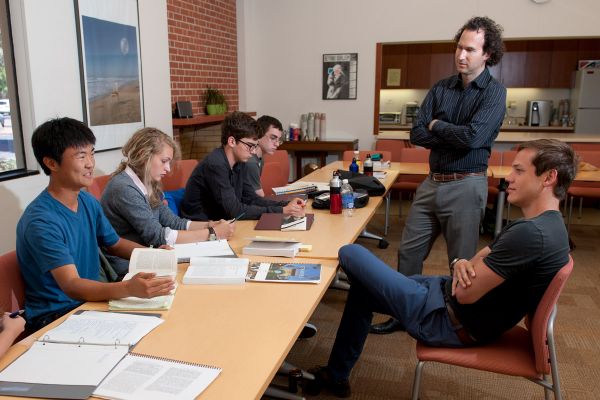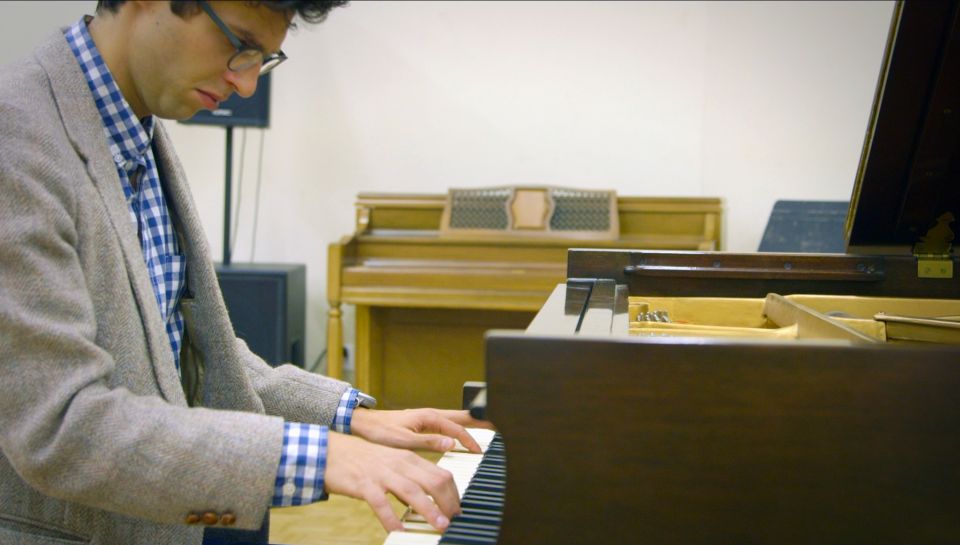With the arrival of new researchers this fall, courtesy of a prestigious fellowship, the Stanford Humanities Center now hosts more fellows than any other humanities institute in the country.
The center annually supports about 50 scholars from all over the world.
“Mixing all of those people at different stages of their career and across a range of academic disciplines is where the magic of the Humanities Center lies,” said Caroline Winterer, director of the Stanford Humanities Center since 2013 and a Stanford history professor.
Winterer’s own research is a case in point. An American historian, she had been reading the letters of Benjamin Franklin for years when a fellowship at the Humanities Center introduced her to digital research methods. She went on to map the social network of Benjamin Franklin, for which she received an American Ingenuity Award from Smithsonian Magazine.
“The cross-fertilization of ideas is essential to cutting-edge research,” said Winterer.
The center sponsors advanced research into the historical, philosophical, literary, artistic and cultural dimensions of the human experience. It offers year-long fellowships to Stanford undergraduates and graduate students, postdoctoral scholars, and faculty members from Stanford and other universities around the world.
Beginning with the 2017-18 academic year, the center now also supports the Andrew W. Mellon Fellowship of Scholars in the Humanities program, which brings 12 postdoctoral scholars in humanities disciplines to Stanford.
When it was founded in 1982, the center supported fewer than 10 fellows a year, and most of them were Stanford faculty members, Winterer said. But as the center grew, it nurtured researchers and scholars who went on to win Pulitzer Prizes and MacArthur Foundation “genius” grants, and to become university presidents.
“For nearly four decades, this center has been an incubator for intellectual leaders on the national and global stage,” said Winterer.
Former Stanford Humanities Center fellows have examined the moral significance of actions that cause climate change, literary and scientific education in postwar North and South Korea, and the jazz culture and racist history of New York City’s Harlem neighborhood in the 1920s, among other research topics.
Stories about research at the Stanford Humanities Center
Undergraduate students:

Professor of French and Italian Dan Edelstein (standing) and resident counselor Nathan Lindborg lead a group discussion as part of the Stanford Summer Humanities Institute in July 2012. (Image credit: L.A. Cicero)
Stanford faculty:

Historian Londa Schiebinger, a new 2017-18 fellow at the Stanford Humanities Center, studied the history of medical experimentation on slaves on Caribbean plantations. (Image credit: L.A. Cicero)
Visiting researchers:

Historian Elaine Pagels delivered an endowed lecture in April 2017 at the Stanford Humanities Center on the origins of Satan. (Image credit: Steve Castillo)
Mentoring young scholars
During Winterer’s tenure as director, a major priority has been to usher younger scholars into the center.
“We can start introducing students to the methods of humanities research very early,” said Winterer, whose recent interview on Stanford Graduate School of Education’s School’s In radio program emphasizes the critical importance of humanities teaching and research.
Graduate students can work on their dissertations through the Geballe, Lieberman and Mellon fellowships, and seniors can develop their honors thesis at the center. The Hume Humanities Honors Fellowships program brings Stanford seniors to the center to complete a capstone thesis project.
The center’s reach also extends beyond Stanford students with the Summer Humanities Institute, one of the only national summer high school programs to be taught by tenured and tenure-track faculty.
“Just like scientists, we ask the big questions that help us reexamine our most fundamental and cherished truths. … If the sciences are about understanding the natural world, the humanities are about understanding the human world.”
—Caroline Winterer
Winterer shared some of her thoughts about the significance of humanities research and the impact it has on the world.
What does it mean to be a humanist scholar?
It can be difficult to imagine what humanities research actually is. We don’t have labs and chemicals. But just like scientists, we ask the big questions that help us reexamine our most fundamental and cherished truths. I guess you could say that our laboratory is the human condition, past and present. If the sciences are about understanding the natural world, the humanities are about understanding the human world.
Why is humanities research important?
We often think we know some things beyond the shadow of a doubt. Or that there are certain givens that we needn’t bother questioning. But if you scratch the surface, you find that things immediately get more complicated.
Humanities research asks the hard questions about our lives together as people. It lays bare the fundamental complexity and ambiguity of the human condition. What makes a good society and a good government? Is inequality fundamental to human existence? How do we know what “art” is? Is it possible to think about history and science without the interpretive frame of something called “progress”?
Now that the Stanford Humanities Center is the largest of its kind in the country, what can the center achieve now that it couldn’t before?
It’s not about being bigger for the sake of being bigger. It’s about being better: creating more cross-disciplinary ideas and collaborations, and more connections across the campus – to the Law School, the Medical School and beyond. It’s not enough to be the Humanities Center; we want to be the center of the humanities, the place where the campus community convenes to tackle big questions about the human experience.
The centers and institutes at Stanford are like storms: They create conditions of intellectual unpredictability. From that, comes innovation. At the Stanford Humanities Center, we innovate by constantly challenging our preconceptions about humanity past and present.
